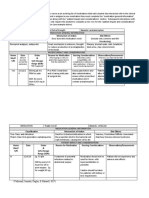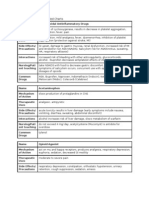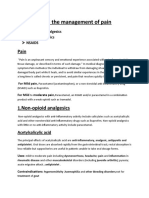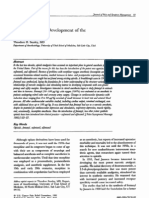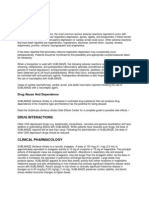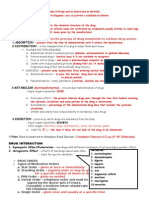Pain and Inflammation Med Charts
Pain and Inflammation Med Charts
Uploaded by
surviving nursing schoolCopyright:
Available Formats
Pain and Inflammation Med Charts
Pain and Inflammation Med Charts
Uploaded by
surviving nursing schoolOriginal Description:
Original Title
Copyright
Available Formats
Share this document
Did you find this document useful?
Is this content inappropriate?
Copyright:
Available Formats
Pain and Inflammation Med Charts
Pain and Inflammation Med Charts
Uploaded by
surviving nursing schoolCopyright:
Available Formats
Pain and Inflammation Med Charts
Name Nonsteroidal Antinflammatory Drugs
Mechanism inhibition of cyclooxygenase, results in decrease in platelet aggregation,
of Action inflammation, fever, pain
Therapeutic inflammation, mild analgesia, fever, dysmenorrhea, inhibition of platelet
Uses aggregation (protection against stroke, MI)
Side Effects/ GI upset, damage to gastric mucosa, renal dysfunction, increased risk of
Precautions MI and stroke(for non ASA NSAIDS), Salicylism risk for ASA(tinnitus,
sweating, HA, respiratory aklaosis)
Interactions increased risk of bleeding with other anticoagulants, glucocorticoids,
alcohol. Ibuprofen decreases antiplatelet effects of ASA
Nursing/Pati take NSAIDS with food to decrease gastric discomfort, notify provider if
ent teaching symptoms of salicylism occurs, concurrent use with opioids allow for lower
dosages of opioids
Common ASA, Ibuprofen, Naproxen, Indomethacin (Indocin), Ketorolac (Toradol),
Drugs Meloxicam (Mobic), Colecoxib (Celebrex)
Name Acetaminophen
Mechanism slows production of protaglandins in CNS
of Action
Therapeutic analgesic, antipyretic
Uses
Side Effects/ acute toxicity results in liver damage (early symptoms include nausea,
Precautions vomiting, diarrhea, sweating, abdominal discomfort)
Interactions alcohol increases risk of liver damage, slows metabolism of warfarin
Nursing/Pati do not exceed 4 mg/ day, acetylcysteine (Mucomyst) is antidote for
ent teaching overdose
Common tylenol
Drugs
Name Opioid Agonist
Mechanism act on mu and kappa receptors, produces analgesia, respiratory
of Action depression, euphoria, sedation, decreased GI motility
Therapeutic moderate to severe pain
Uses
Side Effects/ respiratory depression, constipation, orthostatic hypotension, urinary
Precautions retention, cough suppression, sedation, emesis
Interactions CNS depressants have additive depression action. Anticholinergics,
antihistamines, tricyclic antidepressants have additive anticholinergic
effects. MAOIs may cause hyperpyrexic coma.
Nursing/Pati overdose triad: coma, repiratory depression, pinpoint pupils. Administer
ent teaching very slowly, over 4 to 5 minutes. Narcan is antidote. Do not administer
more than 600 mg/24 hour period for meperidine (Demerol).
Common morphine, Fentanyl (Sublimaze, Duragesic), Meperidine (Demoerol),
Drugs Methadone (Dolophine), Codeine/oxycodone (OxyContin)
Name Agonist - antagonist opioids
Mechanism antagonists act on mu and kappa receptors, lower potential for abuse, less
of Action respiratory depression, and less analgesic effect compared to pure opioid
agonists
Therapeutic moderate to sever pain, treament of opioid dependence, adjunct to
Uses balanced anesthesia,,
Side Effects/ sedation, respiratory depression, dizziness, increased intracranial
Precautions pressure, HA, increased cardiac workload. abstinence syndrome (for those
who are dependant on opioids)
Interactions additive CNS depression with other CNS depressants, opioid agonists may
antagonize and reduce analgesic effects (do not use concurrently)
Nursing/Pati caution when undisclosed opioid use is suspected. Again, opioid agonist
ent teaching and opioid agonist antagonist should not be used together. Naloxone
(narcan) is antidote
Common butorphanol (Stadol), hydrochloride (Nubain), Buprenorphine
Drugs hydrochloride (Buprenex)
Adjuvant Medications for Pain: used with a primary pain medication,
usually an opioid agonist in order to reduce opioid dosage to reduce side
effects.
NSAIDS treats inflammation.
side effects: bone marrow suppresion, GI distress
Tricyclic treats depression, neuropathic pain such as cramping/aching/burning.
antidepress (amitriptyline (Elavil))
ants side effects: orthostatic hypotension, sedation, anticholinergic effects
Anticonvuls neuropathic pain (carbamazepine (Tegretol), gabapentin (Neurontin))
ants side effects: bone marrow suprresion, GI distress
CNS analgesia, decrease sedation. (methylphenidate (Ritalin))
stimulants side effects: weight loss, insomnia
Antihistami decrease anxiety, prevent insomnia and relieve nausea (hydroxyzine
nes (Vistaril))
Bisphospho manage hypercalcemia and bone pain (etidronate (Didronel))
nates side effects: flu like symptoms, venous irritation, renal failure
glucocortico decrease pain from intracranial pressure and spinal cord compression.
ids (dexamethason (Didronel))
side effects: adrenal insufficiency, osteoporosis, hypokalemia, glucose
intolerance, peptic ulcer disease
Name Migraine Meds
Mechanism prevent inflammation and dilation of the intracranial blood vessels,
of Action relieving migraine pain
Therapeutic stopping acute migraine attacks, prevention of chronic migrains
Uses
Side Effects/ depends on type (pg 473)
Precautions
Interactions depends on type
Nursing/Pati avoid trigger factors that cause stress (alcohol, fatigue, tyramine
ent teaching containing foods (aged cheese))
Common Ergot alkaloids: ergotamine (Ergostat)
Drugs Serotonin receptor agonist: sumatriptan (Imitrex)
Beta Blockers: propranolol (Inderal)
Anticonvulsants: divalproex (Depakote)
Tricyclic antidepressants: anitriptyline (Elavil)
Calcium channel blockers: verapamil (Calan)
Estrogens: Estraderm
Ergot alkaloids: Cafergot
Name Local Anesthetics
Mechanism decrease pain by blocking conduction of pain impulses in a specific area
of Action
Therapeutic dental procedures, minor surgical procedures, labor and delivery, regional
Uses anesthesia, skin and mucous membrane disorders, minor procedures (IV
insertion, injection, wart removal)
Side Effects/ CNS excitation (seizures, followed by respiratory depression, leading to
Precautions unconsciousness), hypotension, can prolong labor
Interactions additive hypotensive effects with parenteral administration
Nursing/ vasoconstrictors (epinephrine) often used in combination with local
Patient anesthetic to stop the spread. topical cream applied one hour before
teaching procedure.
Common lidocaine (Xylocaine), tetracain (Pontocaine), procain (Novocain)
Drugs
You might also like
- ECG Interpretation Cheat SheetDocument1 pageECG Interpretation Cheat Sheethirsi20051883% (30)
- Cardiac Dysrhythmia Chart Med-Surg NUR4Document3 pagesCardiac Dysrhythmia Chart Med-Surg NUR4ktfosterfd2095% (100)
- Nina Bacteria Chart Medical School Step 1Document11 pagesNina Bacteria Chart Medical School Step 1M Patel100% (1)
- Heart Failure Topic DiscussionDocument11 pagesHeart Failure Topic Discussionapi-665372449100% (1)
- Lab ValuesDocument3 pagesLab Valuessurviving nursing school100% (3)
- Drug Suffixes Cheat Sheet Sorted AlphabeticallyDocument3 pagesDrug Suffixes Cheat Sheet Sorted Alphabeticallystudynote155No ratings yet
- Top 300 Drugs Pocket Reference Guide (2021 Edition)From EverandTop 300 Drugs Pocket Reference Guide (2021 Edition)Rating: 5 out of 5 stars5/5 (1)
- Antiarrhythmic Medication Chart - EBM Consult v3Document2 pagesAntiarrhythmic Medication Chart - EBM Consult v3Linlin100% (1)
- Infectious Diseases IDocument7 pagesInfectious Diseases ITiff VoNo ratings yet
- Pharmacology Important Things To RememberDocument5 pagesPharmacology Important Things To RememberHydie100% (1)
- Naplex Complete Study Outline A Topic-Wise Approach DiabetesFrom EverandNaplex Complete Study Outline A Topic-Wise Approach DiabetesRating: 4 out of 5 stars4/5 (3)
- Psychiatric Nursing ReviewDocument16 pagesPsychiatric Nursing Reviewɹǝʍdןnos97% (63)
- Cardiovascular SystemDocument10 pagesCardiovascular Systemsurviving nursing school100% (2)
- Fentanyl inDocument10 pagesFentanyl inSisQha LuCiiajjaNo ratings yet
- Pro MetricDocument138 pagesPro Metricahmed100% (8)
- A-Autonomic Drugs: 1) CholinergicDocument28 pagesA-Autonomic Drugs: 1) CholinergicMahmoud Ahmed MahmoudNo ratings yet
- Pharmacology of Cardiac Diseases MINEDocument3 pagesPharmacology of Cardiac Diseases MINEMitu Miressa ت100% (1)
- Remembering Medication ClassificationsDocument2 pagesRemembering Medication ClassificationsGVHHNo ratings yet
- Total Pharmacy Notes TPN For EEDocument1,601 pagesTotal Pharmacy Notes TPN For EEClaire Cura100% (2)
- Gout DrugsDocument1 pageGout DrugsMichael BrownNo ratings yet
- Kaplan Notes. ExamenSO IMPORTANTDocument145 pagesKaplan Notes. ExamenSO IMPORTANTLisaNo ratings yet
- Drugclasses Pharmacologypart 1 PDFDocument25 pagesDrugclasses Pharmacologypart 1 PDFSutanya100% (3)
- Diabetes Mellitus Drug ChartDocument3 pagesDiabetes Mellitus Drug Chartlui.stephanie1751100% (1)
- Pharmocology Drug Cards: InnovarDocument33 pagesPharmocology Drug Cards: InnovarfaizaNo ratings yet
- Abx FinalDocument3 pagesAbx Finalyanks1120No ratings yet
- Drug SuffixesDocument3 pagesDrug SuffixesjeromeasuncionNo ratings yet
- Hmg-Coa Reductase Inhibitors (Statins) : Side Effects, Contraindications, InteractionsDocument6 pagesHmg-Coa Reductase Inhibitors (Statins) : Side Effects, Contraindications, Interactionswaste78No ratings yet
- Drug Interactions: What Is An Interaction?Document4 pagesDrug Interactions: What Is An Interaction?Leyla MajundaNo ratings yet
- Neuro Psych - Antiepileptic Drug ChartDocument5 pagesNeuro Psych - Antiepileptic Drug ChartMonica J Ortiz Pereira100% (1)
- Anticoagulants Drug TableDocument1 pageAnticoagulants Drug TableNicole HoNo ratings yet
- TLDR HIV Cheat Sheet v2Document1 pageTLDR HIV Cheat Sheet v2AisleenHNo ratings yet
- Drug Card Emergency Department-1 PDFDocument2 pagesDrug Card Emergency Department-1 PDFdrmohdtanveer100% (1)
- AntidotesDocument2 pagesAntidotesYemaya84No ratings yet
- Top 200 Drug Study Reference RLPDocument31 pagesTop 200 Drug Study Reference RLPYathrika Yathrika100% (1)
- Hypertension Drugs Cheat Sheet: by ViaDocument3 pagesHypertension Drugs Cheat Sheet: by ViaGulzaib KhokharNo ratings yet
- NCLEX Review: Pharmacology Charlene Natale, BSN, RNDocument43 pagesNCLEX Review: Pharmacology Charlene Natale, BSN, RNMenly Susada100% (1)
- Drug of ChoiceDocument5 pagesDrug of ChoiceAsmaa Radwan100% (1)
- Summary of Antidiabetic Drugs PDFDocument3 pagesSummary of Antidiabetic Drugs PDFZinc Yulo100% (1)
- Diabetes Topic DiscussionDocument9 pagesDiabetes Topic DiscussionSamNo ratings yet
- Drug ClassDocument13 pagesDrug ClassEdfren Salazar Colon100% (1)
- Ninja - Anti-HTN PDFDocument6 pagesNinja - Anti-HTN PDFErica Hyeyeon Lee100% (2)
- Pharmacology Drug Chart: Drug Name Receptor Therapeutic Uses Adverse EffectsDocument18 pagesPharmacology Drug Chart: Drug Name Receptor Therapeutic Uses Adverse EffectsPadmavathy Naidu Chokkapu100% (2)
- Whole Pharmacology Classification: Adrenergic Antagonists Alpha Adrenergic Antagonists Alpha 1 AntagonistsDocument17 pagesWhole Pharmacology Classification: Adrenergic Antagonists Alpha Adrenergic Antagonists Alpha 1 AntagonistsFlorina TrutescuNo ratings yet
- Mnemonics PDFDocument15 pagesMnemonics PDFbeingfiredNo ratings yet
- Drug Interactions 2 Paper PDFDocument2 pagesDrug Interactions 2 Paper PDFAzima AbdelrhamanNo ratings yet
- PCOL Maps PDFDocument11 pagesPCOL Maps PDFZinc YuloNo ratings yet
- Antiarrhythmic Drugs 1Document32 pagesAntiarrhythmic Drugs 1AliImadAlKhasakiNo ratings yet
- The Ultimate Review For MedicalDocument15 pagesThe Ultimate Review For MedicalJap Avila BernasNo ratings yet
- Respiratory System: Antiasthmatic Drugs Cardiac GlycosidesDocument4 pagesRespiratory System: Antiasthmatic Drugs Cardiac GlycosidesNurse Hooman100% (1)
- Pharmacology Drug ChartDocument50 pagesPharmacology Drug ChartEssentialForLiving100% (1)
- Pharmacology of Drugs Used in Bronchial Asthma & COPDDocument84 pagesPharmacology of Drugs Used in Bronchial Asthma & COPDdfngjlnNo ratings yet
- Diabetes Treatment: PancreatitisDocument2 pagesDiabetes Treatment: PancreatitisSafiya JamesNo ratings yet
- DRUG SUMMARY TABLE - Anticoagulantes y AntiagregantesDocument3 pagesDRUG SUMMARY TABLE - Anticoagulantes y AntiagregantesManuel BetancurNo ratings yet
- Antiepileptic Drugs AED: D' DI Disadv SE AdvDocument1 pageAntiepileptic Drugs AED: D' DI Disadv SE Advrayooona88No ratings yet
- Pharmacology Quick HitsDocument6 pagesPharmacology Quick HitsHuma Hameed DogarNo ratings yet
- Basic Drug Cards 1Document13 pagesBasic Drug Cards 1Sara Sabra100% (1)
- Drugs SummaryDocument23 pagesDrugs Summaryapi-3832811100% (1)
- Clinical Med CardsDocument26 pagesClinical Med CardsLila Daniels100% (1)
- Drug ListDocument30 pagesDrug ListKristineNo ratings yet
- Agents Causing Coma or SeizuresDocument3 pagesAgents Causing Coma or SeizuresShaira Aquino VerzosaNo ratings yet
- Pharmacology Dr. Scott PDFDocument90 pagesPharmacology Dr. Scott PDFSingey LhendupNo ratings yet
- Pharmacology Bundle Study GuideDocument47 pagesPharmacology Bundle Study GuideAmisalu Nigusie100% (2)
- Psycho PharmaDocument8 pagesPsycho PharmaMark JosephNo ratings yet
- Pain Med ChartsDocument4 pagesPain Med ChartsNursingSchoolNotesNo ratings yet
- Pain and Inflammation: (General Key Points)Document38 pagesPain and Inflammation: (General Key Points)susan2johnson-501300No ratings yet
- PREPUMASTERKEY (Repaired)Document2,031 pagesPREPUMASTERKEY (Repaired)surviving nursing schoolNo ratings yet
- PREPUMASTERKEY (Repaired)Document2,031 pagesPREPUMASTERKEY (Repaired)surviving nursing schoolNo ratings yet
- Hematologic System Drug ChartsDocument2 pagesHematologic System Drug Chartssurviving nursing schoolNo ratings yet
- Perioperative NursingDocument12 pagesPerioperative Nursingtheglobalnursing100% (12)
- Major Fluid and Electrolyte ImbalancesDocument5 pagesMajor Fluid and Electrolyte ImbalancestheglobalnursingNo ratings yet
- Therapeutic DietsDocument8 pagesTherapeutic DietsmArLoN91% (11)
- 100 Essential Drugs1Document8 pages100 Essential Drugs1Sudip DevadasNo ratings yet
- Digestive Domain Guide 1Document31 pagesDigestive Domain Guide 1surviving nursing school100% (1)
- Disease Cheat SheetDocument393 pagesDisease Cheat Sheetsurviving nursing school50% (2)
- Final Edited Version - Patho Bible 1Document139 pagesFinal Edited Version - Patho Bible 1RosemaryCastro100% (1)
- Vitamin Chart 2Document3 pagesVitamin Chart 2surviving nursing schoolNo ratings yet
- ECG StripsDocument5 pagesECG Stripssurviving nursing school100% (2)
- Endocrine NursingDocument2 pagesEndocrine Nursingsurviving nursing school100% (2)
- Cardiac Study GuideDocument11 pagesCardiac Study Guidesurviving nursing school100% (2)
- ATI Bible 1Document205 pagesATI Bible 1surviving nursing school100% (1)
- Gastrointestinal System and Nutrition Drug ChartsDocument4 pagesGastrointestinal System and Nutrition Drug Chartssurviving nursing schoolNo ratings yet
- Musculoskeletal ChartsDocument27 pagesMusculoskeletal Chartssurviving nursing school100% (3)
- FE Imbalance HandoutsDocument2 pagesFE Imbalance HandoutsPrasanth Kurien Mathew100% (2)
- Neurology Domain GuideDocument29 pagesNeurology Domain Guidesurviving nursing schoolNo ratings yet
- Hematologic System Drug ChartsDocument2 pagesHematologic System Drug Chartssurviving nursing schoolNo ratings yet
- Cardiac DrugsDocument10 pagesCardiac Drugssurviving nursing school100% (5)
- Resp Lecture NotesDocument18 pagesResp Lecture Notessurviving nursing schoolNo ratings yet
- Tramadol As An Analgesic For Mild To Moderate Cancer Pain: Wojciech LeppertDocument15 pagesTramadol As An Analgesic For Mild To Moderate Cancer Pain: Wojciech LeppertSinggih Nisyah PrasetyoNo ratings yet
- Pain MedicationsDocument3 pagesPain Medicationsapi-3739910100% (1)
- Drugs Used in The Management of Pain: Non Opioid AnalgesicsDocument6 pagesDrugs Used in The Management of Pain: Non Opioid Analgesicstesfamichael mengistuNo ratings yet
- Pain ManagementDocument16 pagesPain ManagementAziil LiizaNo ratings yet
- Autacoids Analgesics DR H AboshoushaDocument7 pagesAutacoids Analgesics DR H AboshoushaMoustafa HazzaaNo ratings yet
- Chido2etiology - Evidence-Based Strategies To Reduce The Incidence of Postoperative Delirium - A Narrative Review PDFDocument11 pagesChido2etiology - Evidence-Based Strategies To Reduce The Incidence of Postoperative Delirium - A Narrative Review PDFMikeVDCNo ratings yet
- Anesthesia 2.0 BTRDocument20 pagesAnesthesia 2.0 BTR7y67kccdbgNo ratings yet
- EPM Partic Manual 2e FinalDocument64 pagesEPM Partic Manual 2e FinalRyan GusnaintinNo ratings yet
- List of Dangerous DrugDocument2 pagesList of Dangerous DrugDenver Dela Cruz PadrigoNo ratings yet
- St. Paul University Philippines: /almarallag/v01/2020-21Document3 pagesSt. Paul University Philippines: /almarallag/v01/2020-21Suzete PagaduanNo ratings yet
- ShiverDocument24 pagesShiverwanoe02No ratings yet
- The History and Development of The Fentanyl Series - TH Stanley - J Pain Symptom Manage, Apr 1992, 7 (3), Suppl 1, S3-S7 - PMID 1517629Document5 pagesThe History and Development of The Fentanyl Series - TH Stanley - J Pain Symptom Manage, Apr 1992, 7 (3), Suppl 1, S3-S7 - PMID 1517629muopioidreceptor100% (1)
- Gastrointestinal System Disorders NCLEX Practice - Quiz #2 - 50 Questions - NurseslabsDocument52 pagesGastrointestinal System Disorders NCLEX Practice - Quiz #2 - 50 Questions - NurseslabsGypsy Joan Trance100% (1)
- Pharmacology Qs Form BookDocument55 pagesPharmacology Qs Form Bookraamki_99No ratings yet
- Postspinalshivering ArticleDocument6 pagesPostspinalshivering ArticleErisha Mae BalagbaganNo ratings yet
- Waiters Morphine PDFDocument2 pagesWaiters Morphine PDFTommieNo ratings yet
- Pharmaco FinalsDocument33 pagesPharmaco FinalsAkashi SilvanoNo ratings yet
- Opioid Analgesics: Ardin S. Berger, D.O. Department of Anesthesiology & Pain Management Version 1, Revised 10/12/19Document30 pagesOpioid Analgesics: Ardin S. Berger, D.O. Department of Anesthesiology & Pain Management Version 1, Revised 10/12/19Songuigama CoulibalyNo ratings yet
- GI NURSESLABS #2 50itemsDocument77 pagesGI NURSESLABS #2 50itemsMikaela DiadidNo ratings yet
- 400 3 NarcoticsDocument27 pages400 3 Narcoticsfirdaus92No ratings yet
- Side Effects: FentanylDocument2 pagesSide Effects: FentanylArianda Nurbani WidyaputriNo ratings yet
- Opioid Analgesics: Just in Time Training September 2006Document16 pagesOpioid Analgesics: Just in Time Training September 2006Yel CMNo ratings yet
- Pharma For StudentsDocument23 pagesPharma For StudentsDominic Reambonanza0% (1)
- Opioids PDFDocument2 pagesOpioids PDFErica Hyeyeon LeeNo ratings yet
- Analgesia and Sedation in Hospitalized Children: by Elizabeth J. Beckman, Pharm.D., BCPS, BCCCP, BCPPSDocument24 pagesAnalgesia and Sedation in Hospitalized Children: by Elizabeth J. Beckman, Pharm.D., BCPS, BCCCP, BCPPSGerald GamboaNo ratings yet
- Opioids: Dr. Yuri Clement, Pharmacology Unit, FMSDocument40 pagesOpioids: Dr. Yuri Clement, Pharmacology Unit, FMSUnixa BraunNo ratings yet
- PHARCAREDocument5 pagesPHARCAREMiguel SantosNo ratings yet
- N C H N N: Removal of (Ring-C and E) Removal of (Ring-E)Document2 pagesN C H N N: Removal of (Ring-C and E) Removal of (Ring-E)Shamael AlsharifNo ratings yet

























































